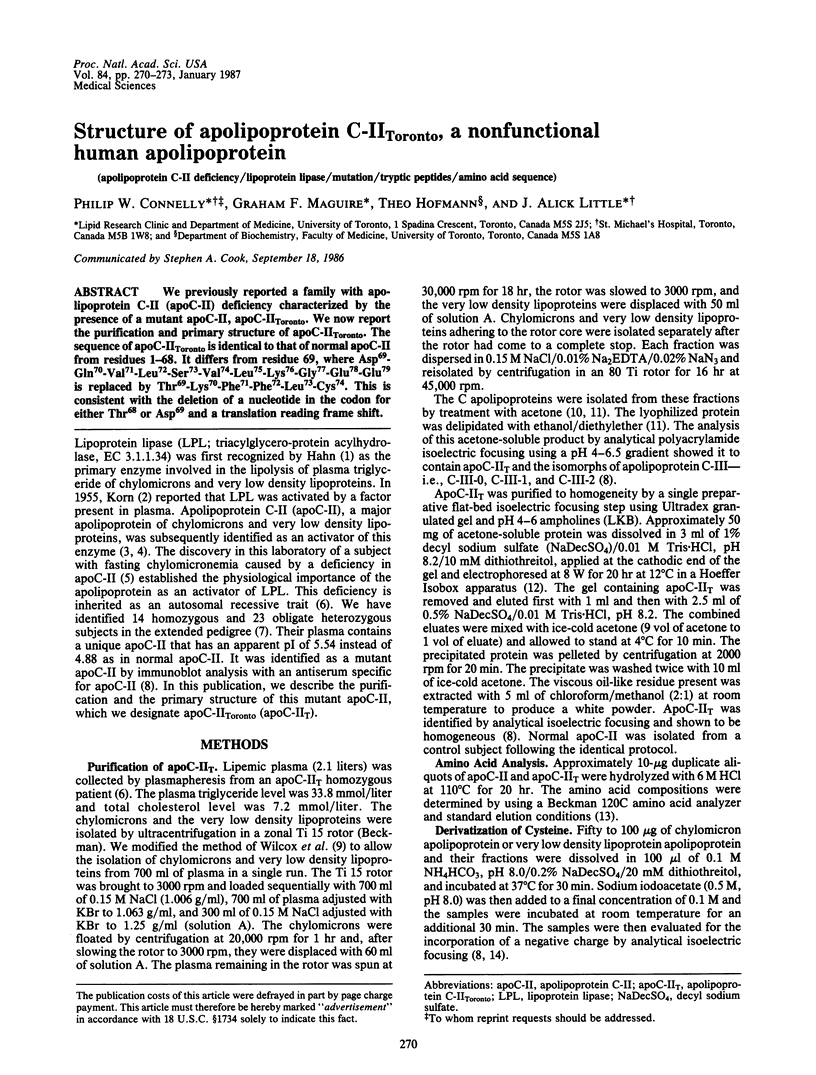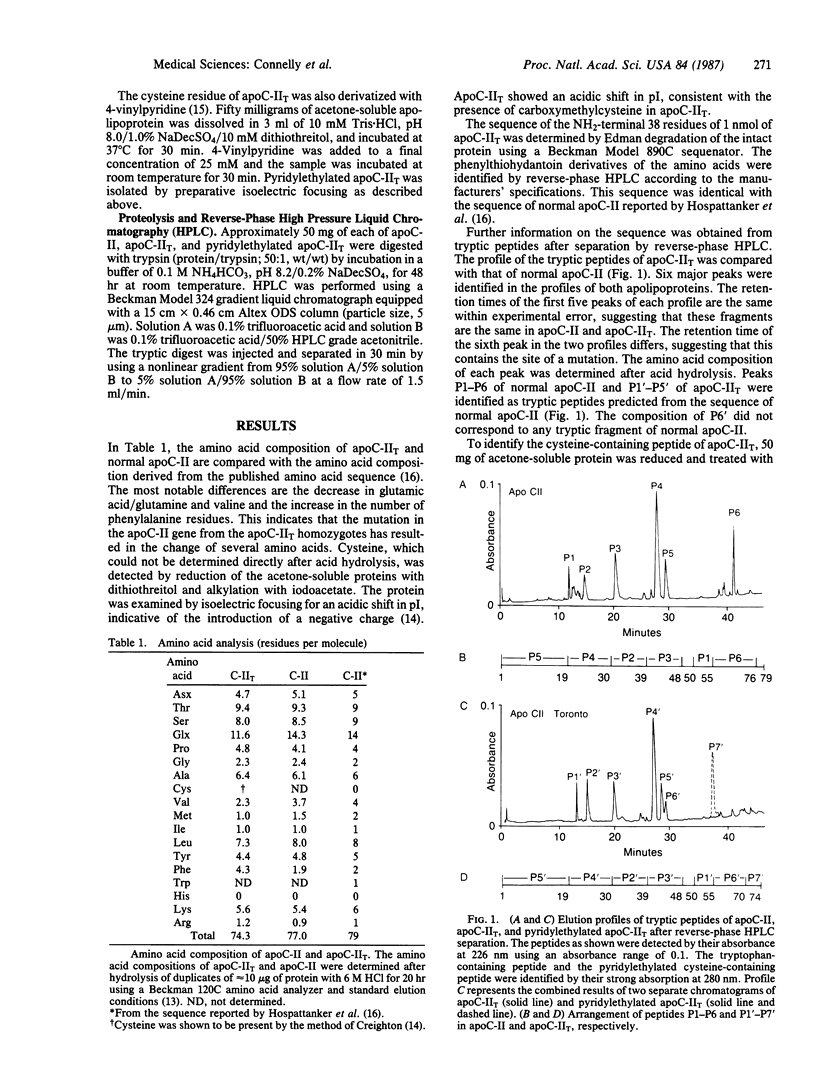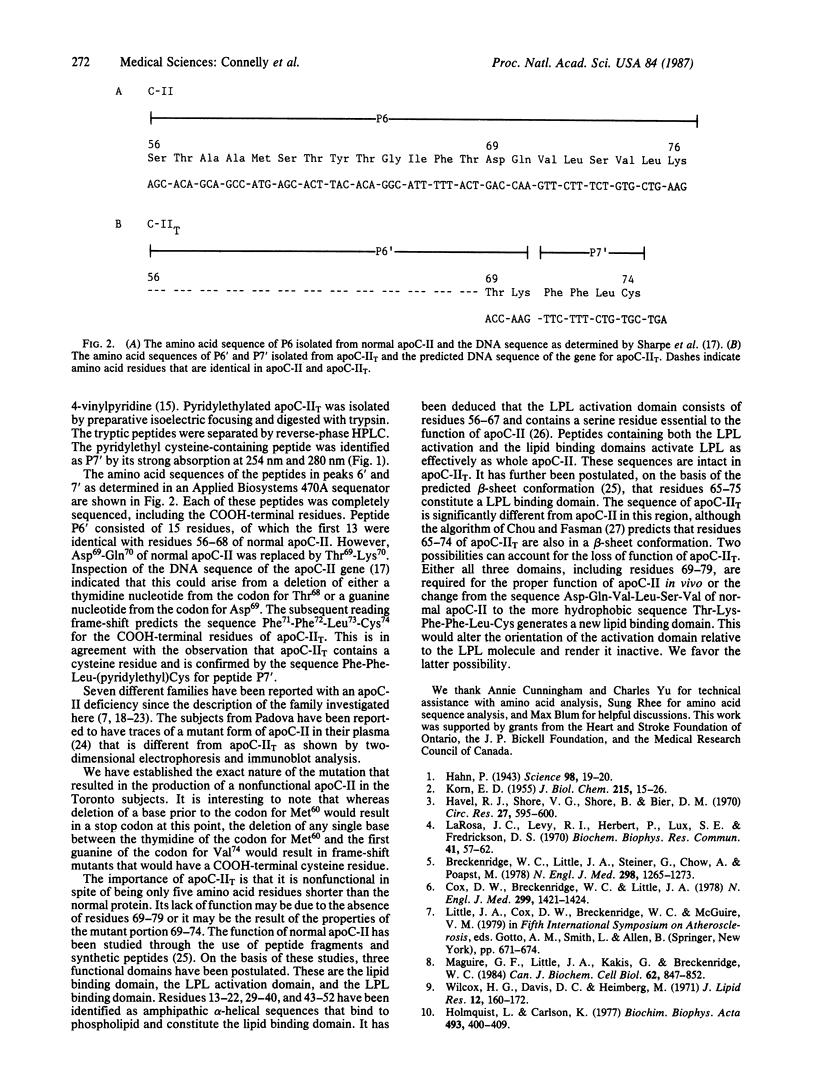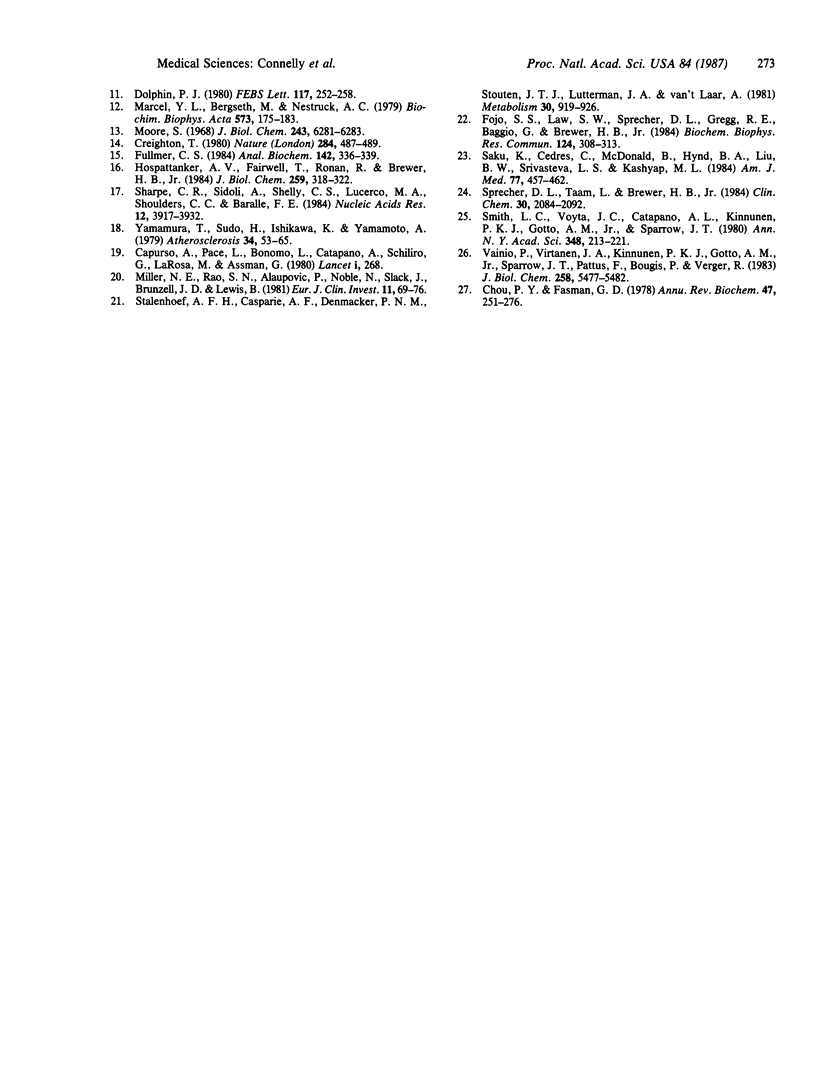Abstract
We previously reported a family with apolipoprotein C-II (apoC-II) deficiency characterized by the presence of a mutant apoC-II, apoC-IIToronto. We now report the purification and primary structure of apoC-IIToronto. The sequence of apoC-IIToronto is identical to that of normal apoC-II from residues 1-68. It differs from residue 69, where Asp69-Gln70-Val71-Leu72-Ser73-Val74- Leu75-Lys76-Gly77-Glu78-Glu79 is replaced by Thr69-Lys70-Phe71-Phe72-Leu73-Cys74. This is consistent with the deletion of a nucleotide in the codon for either Thr68 or Asp69 and a translation reading frame shift.
Full text
PDF



Selected References
These references are in PubMed. This may not be the complete list of references from this article.
- Breckenridge W. C., Little J. A., Steiner G., Chow A., Poapst M. Hypertriglyceridemia associated with deficiency of apolipoprotein C-II. N Engl J Med. 1978 Jun 8;298(23):1265–1273. doi: 10.1056/NEJM197806082982301. [DOI] [PubMed] [Google Scholar]
- Capurso A., Pace L., Bonomo L., Catapano A., Schilirò G., La Rosa M., Assmann G. New case of apoprotein C-II deficiency. Lancet. 1980 Feb 2;1(8162):268–268. doi: 10.1016/s0140-6736(80)90768-0. [DOI] [PubMed] [Google Scholar]
- Chou P. Y., Fasman G. D. Empirical predictions of protein conformation. Annu Rev Biochem. 1978;47:251–276. doi: 10.1146/annurev.bi.47.070178.001343. [DOI] [PubMed] [Google Scholar]
- Cox D. W., Breckenridge W. C., Little J. A. Inheritance of apolipoprotein C-II deficiency with hypertriglyceridemia and pancreatitis. N Engl J Med. 1978 Dec 28;299(26):1421–1424. doi: 10.1056/NEJM197812282992601. [DOI] [PubMed] [Google Scholar]
- Creighton T. E. Counting integral numbers of amino acid residues per polypeptide chain. Nature. 1980 Apr 3;284(5755):487–489. doi: 10.1038/284487a0. [DOI] [PubMed] [Google Scholar]
- Dolphin P. J. Organic extraction and preparative isoelectric focussing of rat serum apolipoproteins. FEBS Lett. 1980 Aug 11;117(1):252–258. doi: 10.1016/0014-5793(80)80956-2. [DOI] [PubMed] [Google Scholar]
- Fojo S. S., Law S. W., Sprecher D. L., Gregg R. E., Baggio G., Brewer H. B., Jr Analysis of the apoC-II gene in apoC-II deficient patients. Biochem Biophys Res Commun. 1984 Oct 15;124(1):308–313. doi: 10.1016/0006-291x(84)90953-7. [DOI] [PubMed] [Google Scholar]
- Fullmer C. S. Identification of cysteine-containing peptides in protein digests by high-performance liquid chromatography. Anal Biochem. 1984 Nov 1;142(2):336–339. doi: 10.1016/0003-2697(84)90473-1. [DOI] [PubMed] [Google Scholar]
- Hahn P. F. ABOLISHMENT OF ALIMENTARY LIPEMIA FOLLOWING INJECTION OF HEPARIN. Science. 1943 Jul 2;98(2531):19–20. doi: 10.1126/science.98.2531.19. [DOI] [PubMed] [Google Scholar]
- Havel R. J., Shore V. G., Shore B., Bier D. M. Role of specific glycopeptides of human serum lipoproteins in the activation of lipoprotein lipase. Circ Res. 1970 Oct;27(4):595–600. doi: 10.1161/01.res.27.4.595. [DOI] [PubMed] [Google Scholar]
- Holmquist L., Carlson K. Selective extraction of human serum very low density apolipoproteins with organic solvents. Biochim Biophys Acta. 1977 Aug 23;493(2):400–409. doi: 10.1016/0005-2795(77)90196-9. [DOI] [PubMed] [Google Scholar]
- Hospattankar A. V., Fairwell T., Ronan R., Brewer H. B., Jr Amino acid sequence of human plasma apolipoprotein C-II from normal and hyperlipoproteinemic subjects. J Biol Chem. 1984 Jan 10;259(1):318–322. [PubMed] [Google Scholar]
- KORN E. D. Clearing factor, a heparin-activated lipoprotein lipase. II. Substrate specificity and activation of coconut oil. J Biol Chem. 1955 Jul;215(1):15–26. [PubMed] [Google Scholar]
- LaRosa J. C., Levy R. I., Herbert P., Lux S. E., Fredrickson D. S. A specific apoprotein activator for lipoprotein lipase. Biochem Biophys Res Commun. 1970 Oct 9;41(1):57–62. doi: 10.1016/0006-291x(70)90468-7. [DOI] [PubMed] [Google Scholar]
- Maguire G. F., Little J. A., Kakis G., Breckenridge W. C. Apolipoprotein C-II deficiency associated with nonfunctional mutant forms of apolipoprotein C-II. Can J Biochem Cell Biol. 1984 Sep;62(9):847–852. doi: 10.1139/o84-108. [DOI] [PubMed] [Google Scholar]
- Marcel Y. L., Bergseth M., Nestruck A. C. Preparative isoelectric focussing of apolipoproteins C and E from human very low density lipoproteins. Biochim Biophys Acta. 1979 Apr 27;573(1):175–183. doi: 10.1016/0005-2760(79)90184-x. [DOI] [PubMed] [Google Scholar]
- Miller N. E., Rao S. N., Alaupovic P., Noble N., Slack J., Brunzell J. D., Lewis B. Familial apolipoprotein CII deficiency: plasma lipoproteins and apolipoproteins in heterozygous and homozygous subjects and the effects of plasma infusion. Eur J Clin Invest. 1981 Feb;11(1):69–76. doi: 10.1111/j.1365-2362.1981.tb01768.x. [DOI] [PubMed] [Google Scholar]
- Moore S. Amino acid analysis: aqueous dimethyl sulfoxide as solvent for the ninhydrin reaction. J Biol Chem. 1968 Dec 10;243(23):6281–6283. [PubMed] [Google Scholar]
- Saku K., Cedres C., McDonald B., Hynd B. A., Liu B. W., Srivastava L. S., Kashyap M. L. C-II anapolipoproteinemia and severe hypertriglyceridemia. Report of a rare case with absence of C-II apolipoprotein isoforms and review of the literature. Am J Med. 1984 Sep;77(3):457–462. doi: 10.1016/0002-9343(84)90102-5. [DOI] [PubMed] [Google Scholar]
- Sharpe C. R., Sidoli A., Shelley C. S., Lucero M. A., Shoulders C. C., Baralle F. E. Human apolipoproteins AI, AII, CII and CIII. cDNA sequences and mRNA abundance. Nucleic Acids Res. 1984 May 11;12(9):3917–3932. doi: 10.1093/nar/12.9.3917. [DOI] [PMC free article] [PubMed] [Google Scholar]
- Smith L. C., Voyta J. C., Catapano A. L., Kinnunen P. K., Gotto A. M., Jr, Sparrow J. T. Activation of lipoprotein lipase by synthetic fragments of apolipoprotein C-II. Ann N Y Acad Sci. 1980;348:213–223. doi: 10.1111/j.1749-6632.1980.tb21302.x. [DOI] [PubMed] [Google Scholar]
- Sprecher D. L., Taam L., Brewer H. B., Jr Two-dimensional electrophoresis of human plasma apolipoproteins. Clin Chem. 1984 Dec;30(12 Pt 1):2084–2092. [PubMed] [Google Scholar]
- Stalenhoef A. F., Casparie A. F., Demacker P. N., Stouten J. T., Lutterman J. A., van 't Laar A. Combined deficiency of apolipoprotein C-II and lipoprotein lipase in familial hyperchylomicronemia. Metabolism. 1981 Sep;30(9):919–926. doi: 10.1016/0026-0495(81)90072-x. [DOI] [PubMed] [Google Scholar]
- Vainio P., Virtanen J. A., Kinnunen P. K., Gotto A. M., Jr, Sparrow J. T., Pattus F., Bougis P., Verger R. Action of lipoprotein lipase on mixed triacylglycerol/phosphatidylcholine monolayers. Activation by apolipoprotein C-II. J Biol Chem. 1983 May 10;258(9):5477–5482. [PubMed] [Google Scholar]
- Wilcox H. G., Davis D. C., Heimberg M. The isolation of lipoproteins from human plasma by ultracentrifugation in zonal rotors. J Lipid Res. 1971 Mar;12(2):160–172. [PubMed] [Google Scholar]
- Yamamura T., Sudo H., Ishikawa K., Yamamoto A. Familial type I hyperlipoproteinemia caused by apolipoprotein C-II deficiency. Atherosclerosis. 1979 Sep;34(1):53–65. doi: 10.1016/0021-9150(79)90106-0. [DOI] [PubMed] [Google Scholar]


